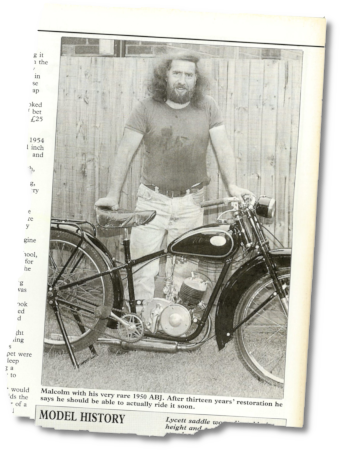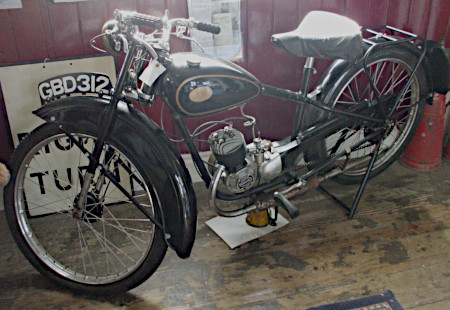
The earliest references to the Raynal Manufacturing Co Ltd at 41–43 Fleet Street, Birmingham, appear around 1914 as a bicycle maker building two-stroke lightweight motor cycles using both Precision and Villiers engines, though it is clear the business must have developed from cycle origins much earlier than this date. A preserved copy of Raynal’s 1922 season trade catalogue, indicated as ‘List No.48’, probably gives the best insight to its activity around this time. The edition illustrates a 2½hp Villiers-powered motor cycle, and offers an extensive range of cycle models, accessories, components and fittings for home trade & export. This year proved the last listing for its motor cycle products, and Raynal continued thereafter as a traditional cycle manufacturer to the trade. Although a large manufacturer, the make Raynal was unknown to the general public as its cycles were ‘supplied without transfer, with customer’s own transfer, or with our stock design transfers’.
On 10 September 1937 Raynal announced the first Villiers Junior engined autocycle in The Motor Cycle magazine, however the Raynal Company enjoyed only the briefest exclusivity of a matter of months before Excelsior announced another Villiers ‘Autobyk’ autocycle at Earls Court Motor Cycle Show in November 1937. Other manufacturers followed and Raynal’s brief monopoly was gone.
When Raynal’s stocks of Junior ‘deflector’ engines ran out in 1939, it switched to the new Villiers 6-port Junior De Luxe motor for 1940, before production ended during the year for the rest of the duration of World War II. Over the wartime period there appears no positive confirmation about quite how the Raynal plant was deployed, though in common with other cycle manufacturers, munitions work would seem likely.
Raynal production resumed in 1946 with a revised Junior De Luxe autocycle but, in 1947 the company was bought by British Plasterboard, though it seems to have continued as before. Long time Managing Director Alfred B Jackson left Raynal at some point after this, to set up his own company: ABJ Cycles, based at 300 Icknield Port Road, Birmingham B16.
While all the other autocycle builders had readily started preparing revised frame designs for the new 2F engine when Villiers announced it in late 1948, Raynal just continued with the old Junior De Luxe machine, and never did produce a next generation autocycle.
The Raynal business was sold on to Tube Investments in 1950, who seemed to have primarily bought it for access to the Dunelt brand. It’s hard to draw a line exactly when Raynal ceased making autocycles, as their obsolete machine just seemed to gradually fade away. They were clearly listing the autocycle up to the end of the sales season in late 1950, though some references suggest that old stock was still being sold up to 1953, while the Raynal brand was absorbed into the sprawling British Cycle Corporation. The Raynal name appeared on some Phillips-made bikes exported to the USA before melting into anonymity within the merged TI–Raleigh.
But the Raynal autocycle is not the focus of this feature…
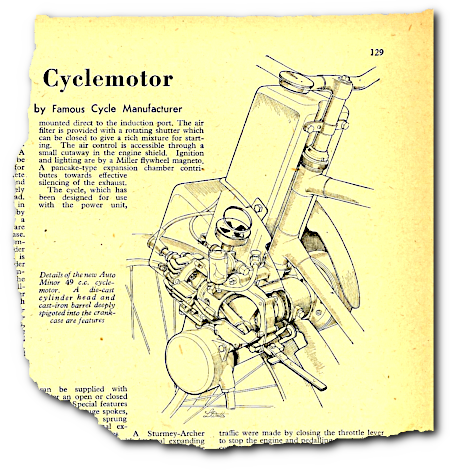
Lawrie Watts’s drawing of the Auto Minor
in The Motor Cycle , 31 July 1952
In July 1949, ABJ announced two similar looking models with Villiers 99cc two-speed 1F motor cycle and single-speed 2F autocycle engines, both with a motor cycle style ‘top-tanks’. The ABJ autocycle was unlike any of its other 2F autocycle contemporaries, where the saddle tank, telescopic front forks and simple, rigid loop frame all contributed to its unique appearance.
The ABJ 1F motor cycle had DC electrics with a rectifier and battery, and though the 2F autocycle only had flywheel magneto AC electrics, it was equipped with an electric horn—an unusual feature for an autocycle of time.
Both autocycle and motor cycle continued in production until 1952, though surviving examples of both models are extremely rare and were probably only produced in very limited numbers.
But neither the ABJ autocycle nor the motor cycle are the focus of this feature…
On 24 July 1952 The Motor Cycle magazine released the first announcement of a new ABJ motorised bicycle named the Auto Minor, with a brief note that ‘It can be supplied mounted on a fork suitable for attaching to most cycles, or complete with special bicycle designed for cyclemotor use. Single speed cycle £39 (+ purchase tax) £41-18s-4d, 3-speed hub model £40-5s (+ pt) £43-9s-2d.’
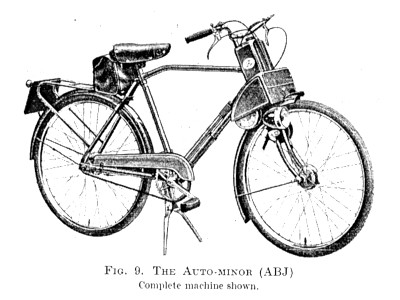
The following week’s edition of The Motor Cycle on 31 July presented more details with a drawn illustration. The unusually short-stroke engine was specified 42mm bore × 36mm stroke for 49.9cc with a cast iron cylinder and alloy head at 6:1 compression, and fitted with a decompression valve. The overhung crank journal was neatly laid across the forks behind the steering headstock, with the carborundum drive roller centrally disposed, and a Miller mag flywheel set arranged to the right. The engine unit assembly weighs about 20lbs and pivots across the fork crown to engage & disengage by a cam-locking lever, though needing to be fixed into each setting position by a nut and bolt, so seemingly ineffective as a practical clutching operation. There wasn’t much to see in period pictures of the Auto-Minor since it just appeared as a tin box on end (the fuel tank), on top of another tin box (the engine cover). It was also now reported that the cycles could be supplied in ‘closed’ (gents) and ‘open’ (ladies) style frames.
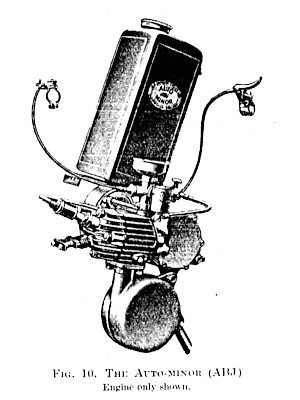
A manufacturer’s speed was given as 25mph with 200+mpg consumption.
Although it was announced in The Motor Cycle edition of 23 October that the ABJ autocycle and motor cycle would be produced alongside the cyclemotor for 1953, the range became suddenly cut back to just the Auto Minor alone, even before the end of 1952!
The ABJ Auto Minor cyclemotor is the focus of our feature, though our test machine only came about from no more than a new, unused bare engine with drive roller, but no mag-set, carb, exhaust, or mounting fork set. The essential front fork had to be fabricated to enable mounting of the engine.
We have the opportunity to assess some of the components that were not explained. The drive roller is a simple carborundum cylinder, just bolted together on a steel core, and not a composite assembly. The original Amal carb was arranged in a downdraft orientation with the air slide set in the horizontal plane, but our subject was rebuilt with a fabricated inlet manifold angled to take a ⅜" Amal 308 in a conventional arrangement.
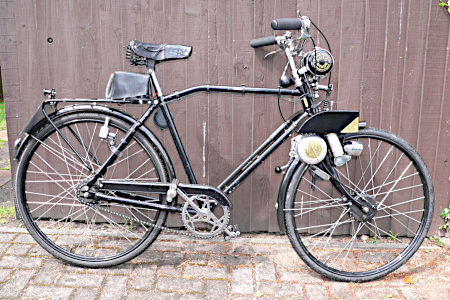
The Auto-Minor was originally presented with a Miller mag-set to power the ignition and a lighting set, but this one has been rebuilt with a Wipac Bantamag set modified to run on a rechargeable battery and coil ignition, so instead this cycle lighting set is powered by a friction driven cycle dynamo from the right hand side of the rear tyre. Our Auto-Minor is mounted in a Triumph Tri-master cycle frame, and its motor engaged by undoing the bar-nut and setting to the optimum required pressure according to the conditions.
A lever with ball knob has been added to ‘tilt’ the engine as something to get hold of when the engine might be hot. A rod with knob works to control the shutter choke through the steel cowl, pull to close and push to clear. This motor came with no fuel tank or engine cover, so uses a Teagle Industrial hedgecutter tank, and the engine cover is fabricated.
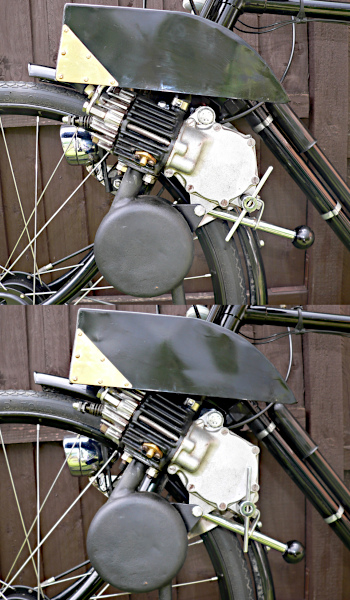
Engine in disengaged (top)
and engaged (bottom) positions
Pull in the decompressor to navigate the bike around with the drive engaged.
Inside, the engine is a conventional Schnuerle-loop lightly domed head piston, but the transfer porting is an interesting arrangement with the transfers placed both sides of the exhaust port, which means the fresh charge is directed to the back of the cylinder. This is pretty unusual for 1952, which we’ve only previously seen and experienced on one other period, though slightly earlier, motor: the Tailwind. Could the ABJ Auto-Minor design be connected? The ‘feel’ of these two machines is remarkably similar. The Tailwind showed no four-stroking effects at all, where gas scavenging was certainly working very efficiently at speed, and we could only presume that its cylinder must have a relatively large exhaust port, which would probably be contributing toward the lack of torque at lower revs. The Auto-Minor also revs cleanly with no four-stroking, though delivers better torque at lower revs, which could be because it has a smaller exhaust port, though that could just as easily be because the ABJ is 21cc (40%) higher capacity than the Tailwind.
Our ABJ holds 22mph on flat and 25 on a light downhill run.
The British Hub Co drum front brake, and single-speed cycle rear with drum brake proved easily capable of arresting a 25mph cyclemotor.
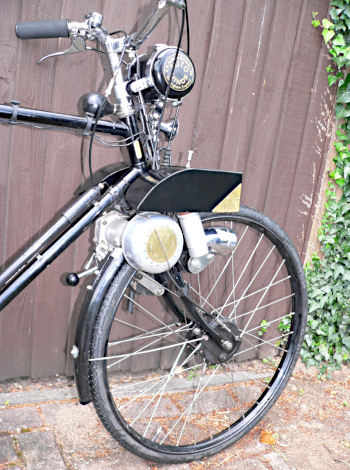
Though the motor runs smoothly with negligible four-stroking, the ABJ still vibrates from the cycle components, so that overhung crank is talking to us, whereas the Tailwind with its extra crankshaft support journal had no such issues.
The Miller mag-set originally fitted to the ABJ would have been somewhat heavier and provided more rotating mass than the Wipac Bantamag on our featured example, which could have changed the engine running characteristics somewhat.
The Auto-Minor was listed for sale during 1953 but seemed to have been dropped at the end of the year, when ABJ reportedly reverted to bicycle manufacture.
There are no clues on any parts of the engine as to who might have made any of the components, but it would seem unlikely it was ABJ’s own work since this would have required iron and aluminium casting and machining facilities, that cycle manufacturers don’t normally have. We can only conclude it was subcontract made, but no idea who might have done this.

It’s a mystery why Alfred Jackson chose to drop the Auto-Minor cyclemotor when all finance and work to produce the engine had already been completed. It’s clear that the required investment into the project wouldn’t have been recovered in such a short time, and there can’t have been many sold because there are simply so few to be found.
Maybe the sales had been so poor that Alfred thought it wasn’t worth any more input.
That might have been because cyclemotors in Britain were invariably attachment engines bought on cost, and cyclemotors complete on bicycles involved the extra cost of the bicycle, which wouldn’t have been part of the equation unless the buyer also needed a new bicycle. The British market never functioned like the European market, which had embraced the concept of the ‘complete’ cyclemotor & bicycle, and the Auto-Minor was only really priced and sold as a complete machine.
Yes, it was suggested that the engine ‘can be supplied mounted on a fork suitable for attaching to most cycles’, but there was never any price even quoted for the motor with its fork kit, and there’s no evidence it was ever actually sold as such. It’s fair to conclude that it was never really intended to sell Auto-Minor other than in the complete cyclemotor & bicycle form, and all other makes of cyclemotor attachment engine kits would have been cheaper. Was this the reason the ABJ cyclemotor didn’t sell?
The Auto-Minor joined the 1F motor cycle and 2F autocycle as failed ABJ projects. There didn’t appear to have been many of any of these machines produced, and surviving examples of all three models are extremely rare.


